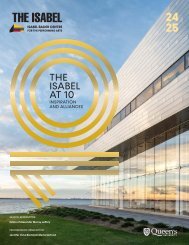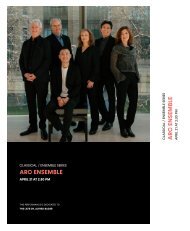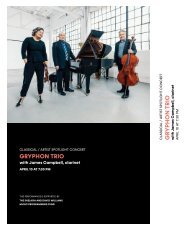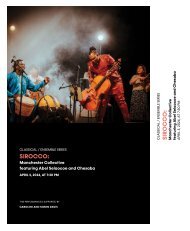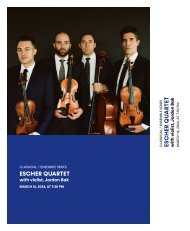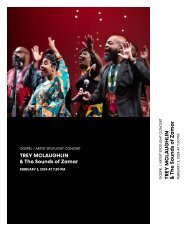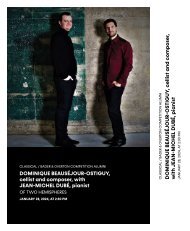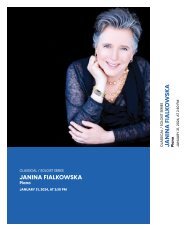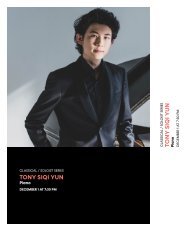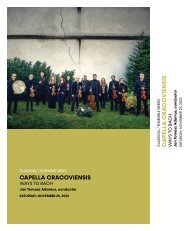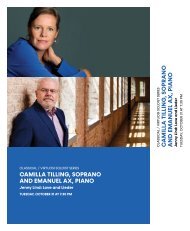You also want an ePaper? Increase the reach of your titles
YUMPU automatically turns print PDFs into web optimized ePapers that Google loves.
PROGRAM NOTES<br />
The string quartet that opens tonight’s concert is<br />
remarkable for the joyously light character that<br />
pervades much of the music. Its nickname, “The<br />
Joke,” is certainly well deserved for two reasons:<br />
first, instead of a Minuet, Haydn writes a faster<br />
Scherzo which includes a Trio that makes great<br />
use of surprising glissandos (or slides) into<br />
pitches; and second, for the way in which the<br />
last movement ends <strong>with</strong> a coda that keeps<br />
interjecting silences that generate a series of false<br />
endings before the final cadence whispers away.<br />
For the vast majority of women musicians and<br />
composers, life and posterity have not been kind,<br />
<strong>with</strong> a clear case of such gender injustice found<br />
in the career and music of Fanny Mendelssohn<br />
(1805-1847). Felix’s older sister by three years,<br />
Fanny was by all accounts just as precocious as<br />
her younger brother, and despite being provided<br />
<strong>with</strong> the same musical tutors as Felix, was<br />
expected to marry and run a family household.<br />
She followed this domestic path, marrying the<br />
Berlin court painter Wilhelm Hensel in 1829, which<br />
coincidentally, was the same year that she began<br />
sketches for a piano sonata that in 1834 she<br />
adapted into her only string quartet. Beyond this<br />
scant information, little more is known of this work<br />
until the music was published in 1988 by Breitkipf<br />
& Härtel, a long-standing publisher of Felix’s<br />
music. The work has since gained considerable<br />
popularity <strong>with</strong> modern audiences for the way it<br />
demonstrates its own unique originality. This can<br />
be immediately heard in the fantasy-like opening<br />
movement that starts expressively in C minor, and<br />
only towards the end settles into the work’s home<br />
key of E flat major. The second movement returns<br />
to C minor in the fast, filigree-like outer sections<br />
that are offset <strong>with</strong> the vibrant fugal writing of<br />
the C major Trio. The Romanze in G minor, displays<br />
subtle fluidity in the melodic writing such that the<br />
music never seems to cadence but is continually<br />
spun into new sections. The final movement, <strong>with</strong><br />
its clear Rondo design and emphasis on exciting<br />
two-part counterpoint doubled at the unison or<br />
in octaves, rounds off the work quite triumphantly<br />
in E flat major.<br />
Many composers seem to have followed Robert<br />
Schumann’s model of writing only one piano<br />
quintet during their careers and making this work<br />
almost symphonic in design and length. Brahms<br />
(1833-1897), whose early career received much<br />
encouragement from Robert Schumann, likewise<br />
composed only one piano quintet. Curiously,<br />
the Brahms piano quintet started out as a string<br />
quintet but was completed as a sonata for two<br />
pianos (a version that is performed today as Opus<br />
34B). At Clara Schumann’s urging, this two-piano<br />
work was adapted for piano and string quartet,<br />
and it is this arrangement that has become a<br />
favourite of chamber music performers and<br />
audiences. All four movements display melodies<br />
and musical textures that are immediately<br />
captivating while at the same time are organized<br />
to support the music’s larger structural form <strong>with</strong><br />
a high degree of controlled expansiveness.<br />
©<strong>20</strong>24 by John Burge for the Isabel<br />
ABOUT ESMÉ QUARTET<br />
At home in Germany, the Esmé <strong>Quartet</strong> is one of<br />
the most dynamic and multi-faceted string quartets<br />
of its generation, winning audiences and reviewers<br />
over <strong>with</strong> its infectious energy and immaculate<br />
ensemble playing. The four South Korean<br />
musicians’ ensemble was the first all-female string<br />
quartet to win the first prize and four special prizes,<br />
including the Mozart and the Beethoven Prize, at<br />
the <strong>20</strong>18 International String <strong>Quartet</strong> Competition<br />
at London’s Wigmore Hall: a sensational launch of<br />
an international string quartet career.<br />
This success in competition also proved the<br />
springboard for worldwide concert activities,<br />
ranging from the USA to Europe’s great musical<br />
centres and all the way to Asia, where they were<br />
celebrated during a prestigious residency at<br />
Seoul’s Lotte Concert Hall during the past season.<br />
Furthermore, innumerable concert tours and<br />
guest appearances have taken the Esmé <strong>Quartet</strong><br />
to festivals and concert halls such as the Lucerne<br />
Festival, the Verbier Festival, the Schleswig-<br />
Holstein Music Festival, London’s Wigmore Hall,<br />
the Flagey Musiq3 Festival in Brussels, L’Auditori<br />
in Barcelona, Teatro La Fenice in Venice, the<br />
Heidelberg String <strong>Quartet</strong> Fest and Hamburg’s<br />
Elbphilharmonie. In the summer of <strong>20</strong>18, they<br />
were also the <strong>Quartet</strong> in Residence at the<br />
Festival d’Aix-en-Provence.





